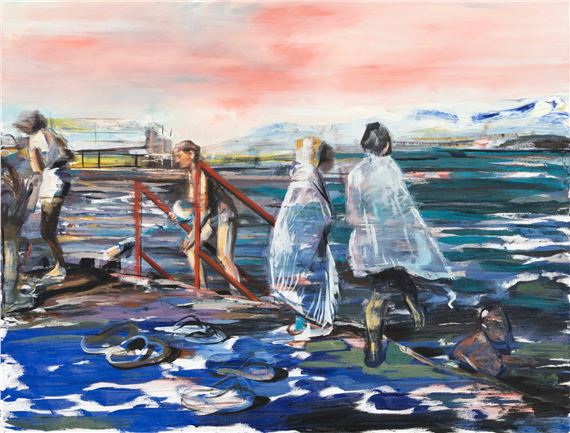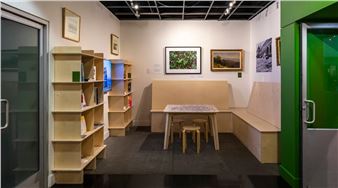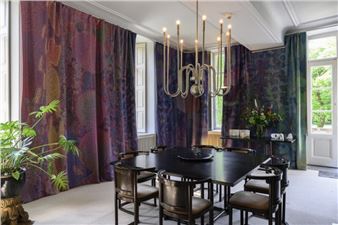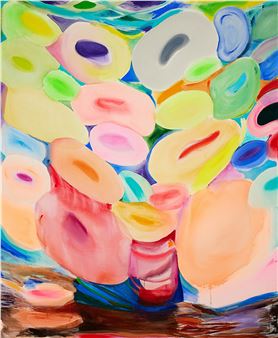Emel Başarık: Number 6
Every work of art boils down to the determination of a frame. Regardless of their boundaries and dimensions, each ultimately presents the scope of a point of view. However, this frame is not measured through the wideness of the surface or plane. It also has a movement toward depth. For example, although a canvas painting may be framed in a square, rectangle, or sometimes other geometric shapes, what will be perceived sometimes breaks the frame and connects the plane with external factors. Many dimensions ranging from memory to experience, from knowledge to intuition, and from emotion to judgment, reach a common dynamic simultaneously.
The artist’s eye seems to wander in the universe and look for a useful frame. A place must be chosen and looked at from such a point that all the lines, colors, areas, textures, etc. that can fit in that frame capture each other within coordinates and show us the reality, lived experience, and perhaps even the truth beyond the frame. After all, how can a composition be described otherwise? So what is a canvas painting or what can we watch there? The first things that catch our eye are probably several objects, figures, spaces, and events happening between them, but their movement towards depth rearranges everything we see, gives it new meaning again, and the composition is thus concluded.
When we encounter the paintings of Edvard Munch, we may find many criticisms about their technique; even the figures, spaces, and events may not interest us or may even repel us. However, when we focus our attention on those paintings, we feel the existence of an atmosphere surrounding the figures, spaces, and events, which is not limited to the composition of figures, space, and events. That atmosphere takes over every situation attempted to be conveyed in the painting and enslaves it to the feeling of a northern light; the events always become autonomous in meaning when subjected to the domination of that light. We must emphasize that the importance of Munch in art history comes from this atmosphere effect, and his compositions are remembered with this feature. David Hockney and Edward Hooper are also like this. Isn’t what we watch in them, beyond a few figures and space, the atmospheres of their own geographies or their own societies? In these paintings, there is usually no exciting or interesting event, but the atmosphere that envelops the spaces is the event and, therefore, the composition itself.

Recommended for you
Every work of art boils down to the determination of a frame. Regardless of their boundaries and dimensions, each ultimately presents the scope of a point of view. However, this frame is not measured through the wideness of the surface or plane. It also has a movement toward depth. For example, although a canvas painting may be framed in a square, rectangle, or sometimes other geometric shapes, what will be perceived sometimes breaks the frame and connects the plane with external factors. Many dimensions ranging from memory to experience, from knowledge to intuition, and from emotion to judgment, reach a common dynamic simultaneously.
The artist’s eye seems to wander in the universe and look for a useful frame. A place must be chosen and looked at from such a point that all the lines, colors, areas, textures, etc. that can fit in that frame capture each other within coordinates and show us the reality, lived experience, and perhaps even the truth beyond the frame. After all, how can a composition be described otherwise? So what is a canvas painting or what can we watch there? The first things that catch our eye are probably several objects, figures, spaces, and events happening between them, but their movement towards depth rearranges everything we see, gives it new meaning again, and the composition is thus concluded.
When we encounter the paintings of Edvard Munch, we may find many criticisms about their technique; even the figures, spaces, and events may not interest us or may even repel us. However, when we focus our attention on those paintings, we feel the existence of an atmosphere surrounding the figures, spaces, and events, which is not limited to the composition of figures, space, and events. That atmosphere takes over every situation attempted to be conveyed in the painting and enslaves it to the feeling of a northern light; the events always become autonomous in meaning when subjected to the domination of that light. We must emphasize that the importance of Munch in art history comes from this atmosphere effect, and his compositions are remembered with this feature. David Hockney and Edward Hooper are also like this. Isn’t what we watch in them, beyond a few figures and space, the atmospheres of their own geographies or their own societies? In these paintings, there is usually no exciting or interesting event, but the atmosphere that envelops the spaces is the event and, therefore, the composition itself.
Artists on show
Contact details


 ARTISTS
ARTISTS















